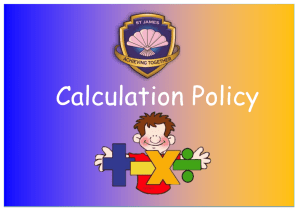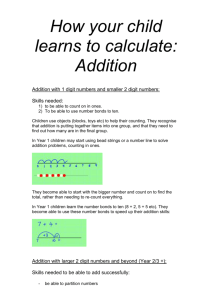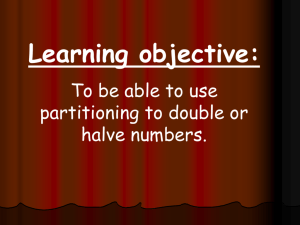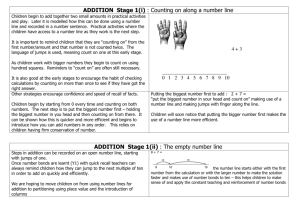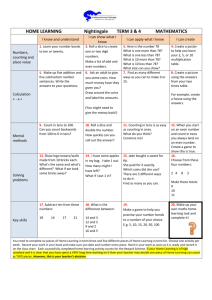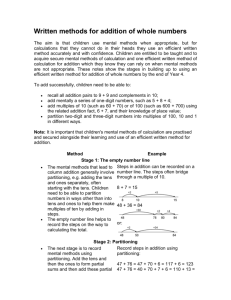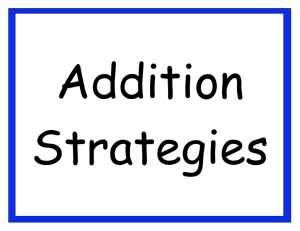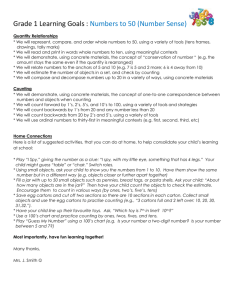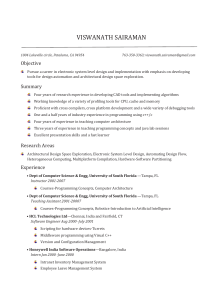Big Maths Written Methods for Addition.
advertisement
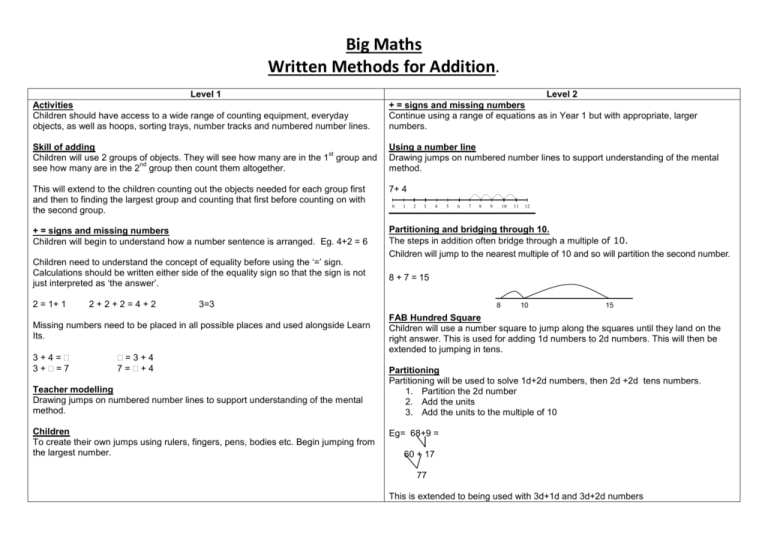
Big Maths Written Methods for Addition. Level 1 Activities Children should have access to a wide range of counting equipment, everyday objects, as well as hoops, sorting trays, number tracks and numbered number lines. Level 2 + = signs and missing numbers Continue using a range of equations as in Year 1 but with appropriate, larger numbers. Skill of adding st Children will use 2 groups of objects. They will see how many are in the 1 group and nd see how many are in the 2 group then count them altogether. Using a number line Drawing jumps on numbered number lines to support understanding of the mental method. This will extend to the children counting out the objects needed for each group first and then to finding the largest group and counting that first before counting on with the second group. 7+ 4 + = signs and missing numbers Children will begin to understand how a number sentence is arranged. Eg. 4+2 = 6 Partitioning and bridging through 10. The steps in addition often bridge through a multiple of 10. Children will jump to the nearest multiple of 10 and so will partition the second number. Children need to understand the concept of equality before using the ‘=’ sign. Calculations should be written either side of the equality sign so that the sign is not just interpreted as ‘the answer’. 2 = 1+ 1 2+2+2=4+2 1 2 3 4 =3+4 7=+4 Teacher modelling Drawing jumps on numbered number lines to support understanding of the mental method. Children To create their own jumps using rulers, fingers, pens, bodies etc. Begin jumping from the largest number. 5 6 7 8 9 10 11 12 8 + 7 = 15 3=3 Missing numbers need to be placed in all possible places and used alongside Learn Its. 3+4= 3+=7 0 8 10 15 FAB Hundred Square Children will use a number square to jump along the squares until they land on the right answer. This is used for adding 1d numbers to 2d numbers. This will then be extended to jumping in tens. Partitioning Partitioning will be used to solve 1d+2d numbers, then 2d +2d tens numbers. 1. Partition the 2d number 2. Add the units 3. Add the units to the multiple of 10 Eg= 68+9 = 60 + 17 77 This is extended to being used with 3d+1d and 3d+2d numbers Level 3 Learn Its Learn Its will be used to add together any 2digit tens numbers. Partitioning Partitioning will be used to solve 2d+2d tens numbers. 1. Partition the 2d numbers 2. Add the tens 3. Add on the units Eg= 23+40 = 20 + 40 3 =60 + 3 = 63 Level 4 Partitioning continues to be used for 1dp + 1dp 0.4 + 0.3 1. Think of the digits as tenths 2. Add the tenths 3. Write the answer as a decimal This extends to using decimals bridging across the number 1. Eg. 0.8 + 0.9 Then 1.1dp + 1.1dp 3.4 + 2.5 = 1. Add the units 2. Add the tenths 3. Add the totals Adding any 2 digit numbers by partitioning and writing out 2 separate calculations. 43 + 52 40 + 50 3 + 2 90 5 = 95 This is extended to using 3d numbers 1. Park up the 100s 2. Solve the 2d + 2d as before 3. Add the 100s on Solving 3d + 3d 1. Add the 100s 2. Add the 10s 3. Add the units 4. Add the totals Eg. 241 + 328 200 + 300 = 500 40 + 20 = 60 1+8=9 = 569 Partitioning is extended to working with money 1. Add the pounds 2. Add the tens 3. Add the pence 4. Add the totals 3.4 + 2.5 3+2 5 0.4 + 0.5 0.9 = 5.9 This method is extended to adding 1.2dp + 1.2dp. Then children will write out each calculation: 3.85 + 8.67 3.00 + 8.00 = 11.00 0.80 + 0.60 = 1.40 0.05 + 0.07 = 0.12 = 12.52 This is extended to: 11.00 1.40 0.12+ 12.52 This leads into using the column method as on the main calculation policy.


